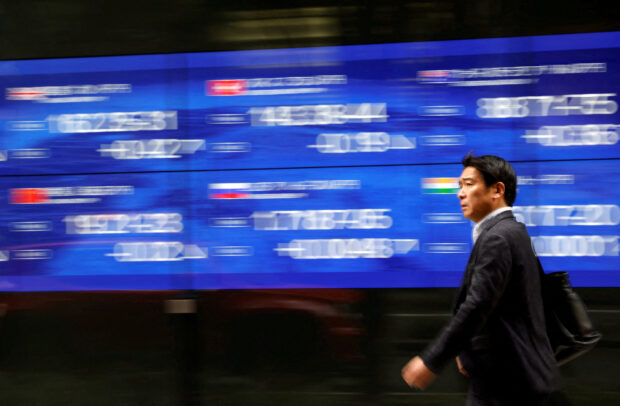
A passerby walks past an electric monitor displaying various countries’ stock price index outside a bank in Tokyo, Japan, March 22, 2023. REUTERS/Issei Kato/File photo
SINGAPORE – Asian stocks rose on Friday as strong corporate earnings lifted sentiment despite lingering worries over economic weakness, while the yen dipped after the Bank of Japan kept rates ultra-low even as it announced a broad review of monetary policy.
MSCI’s broadest index of Asia-Pacific shares outside Japan was 0.51 percent higher but remained on course to end the month lower.
Japan‘s Nikkei jumped 1 percent while the yen weakened 0.72 percent to 134.92 to the dollar and Japanese government bonds rallied.
The BOJ kept its loose monetary settings unchanged but revamped its guidance on the future path of policy, and announced a “broad-perspective” review with a planned time frame of around one to one-and-a-half years.
https://business.inquirer.net/398172/bojs-new-boss-keeps-ultra-low-rates-embarks-on-policy-review
The central bank in its first meeting under new Governor Kazuo Ueda modified its forward guidance by removing a pledge to keep interest rates at “current or lower levels.”
Aninda Mitra, head of Asia macro and investment strategy at BNY Mellon Investment Management, said the BOJ policy decision was not entirely a surprise considering the comments from the new governor before the meeting.
“What I was taken aback by was the amount of time they’ve given themselves to do the comprehensive review,” he said, noting he thought a review would take another quarter or be completed by the end of the year.
“It does seem like the YCC (yield curve control) is here to stay for a while.”
https://business.inquirer.net/396946/boj-open-to-tweaking-ycc-this-year-if-wage-momentum-holds-sources
Markets will now focus on Ueda’s post-meeting news conference for clues on how soon the BOJ could phase out stimulus.
Data earlier on Friday showed core consumer inflation in Japan‘s capital hit 3.5 percent in April, beating expectations and exceeding the BOJ’s 2 percent target.
“As the inflation numbers head higher in Japan, I suspect the markets will start to get more focused on anticipating some sort of a tightening,” said Shane Oliver, chief economist at AMP in Sydney.
Futures indicated European stocks were set to open higher, with Eurostoxx 50 futures up 0.44 percent, German DAX futures up 0.36 percent and FTSE futures up 0.35 percent.
E-mini futures for the S&P 500 eased 0.11 percent after Amazon.com Inc signaled its cloud growth would slow further as its business customers braced for turbulence and clamped down on spending.
Upbeat results from bellwether tech firms, including Meta Platforms Inc, Microsoft Corp and Alphabet Inc have helped lift U.S. stocks higher this week.
“As earnings season accelerates, macro and geopolitical clouds are receding, and company fundamentals are increasingly driving the market,” said Lewis Grant, senior portfolio manager for global equities at Federated Hermes.
China shares gained 0.7 percent, while Hong Kong’s Hang Seng index was 0.71 percent higher. Geopolitical tensions along with worries over the global economic outlook have crimped investor sentiment in recent weeks.
Data overnight showed the U.S. economy slowed more than expected in the first quarter, even as price growth came in hotter than economists had projected.
The core PCE price index, one of the measures of inflation tracked by the Federal Reserve, jumped at a 4.9 percent rate after advancing at a 4.4-percent pace in the prior quarter.
Data also showed that initial claims for unemployment benefits fell, suggesting ongoing tightness in the labor market, a major driver of inflation.
“Stubborn inflation data gives the Fed little breathing room to take heed of nascent slowing in activity and the labor market should it continue to develop,” said Taylor Nugent, an economist at National Australia Bank.
Markets are pricing in an 85 percent chance of the Fed raising interest rates by 25 basis points at its meeting next week, the CME FedWatch tool showed. Traders expect the hike to be the last in the U.S. central bank’s fastest monetary policy tightening cycle since the 1980s.
The yield on 10-year Treasury notes eased 2.3 basis points to 3.505 percent, after clocking their biggest intraday gain since March on Thursday as investors weighed the looming debt ceiling showdown in Washington.
The yield on the 30-year Treasury bond was down 1.9 basis points to 3.738 percent.
The dollar index, which measures the currency against six rivals, was 0.217 percent higher, with the euro down 0.12 percent to $1.1014.
U.S. crude rose 0.52 percent to $75.15 per barrel and Brent was at $78.90, up 0.68 percent on the day.